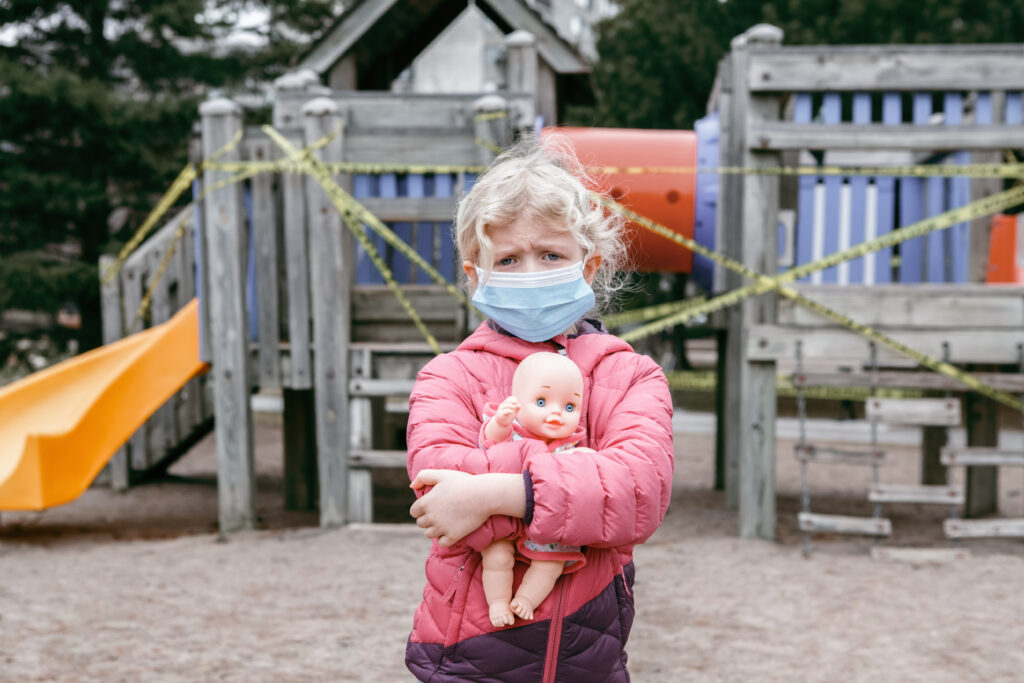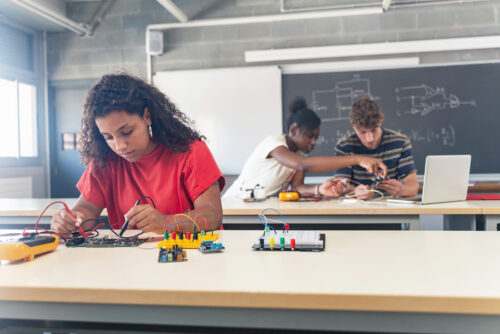There are promising solutions to the learning loss puzzle, but donors need to overcome the “urgency gap” between current recovery efforts and what needs to be done.
Four years ago this March, America’s K-12 public schools began the great school shutdown. America’s K-12 system continues to be haunted by this and the follow-on student learning loss. This ghost, education’s long COVID, threatens to drag down young people’s futures in many ways.
A New York Times article summarizes current thinking on the great and tragic shutdown: “Today, there is broad acknowledgment among many public health and education experts that extended school closures did not significantly stop the spread of COVID, while the academic harms for children have been large and long-standing.”
For example, Stanford economist Eric Hanushek calculates that the lower knowledge and skill levels students experience from learning loss will reduce their average lifetime earnings by as much as 6%. Other adverse effects of learning loss are known to include increased teen motherhood, more incarcerations, and higher arrest rates. Predictably, the most vulnerable young people will suffer the worst consequences.
There are promising solutions to the learning loss puzzle, but there is an “urgency gap” between current recovery efforts and what needs to be done. And K-12 educators cannot be the only ones who work to solve the puzzle. K-12 recovery efforts need an urgent restart as community-wide endeavors.
What follows presents an overview for donors on the learning loss puzzle; how current K-12 recovery efforts should become community-wide endeavors; what programs and activities seem to be working to solve this puzzle; and how all this can be the basis for a community recovery strategy. This information will help donors orient themselves to this urgent problem and help them determine how they might contribute to the recovery effort.
The Learning Loss Puzzle
Learning loss is a complex puzzle. The term describes the significant academic drop in test scores students experienced during the pandemic. This decline is chronicled in many analyses and different measurements, but the results are the same. “Different test. Same story,” writes Mark Schneider, director of the U.S. Institute for Education Sciences. But some good news comes from the 2024 Education Recovery Scorecard. Students in 30 states gained back about one-third of the three-year learning loss in math and one-quarter of the loss in reading. On the other hand, progress is uneven, and learning gaps continue to grow between rich and poor and racial groups.
Five non-academic factors complicate efforts to solve the learning loss puzzle: (1) declining student mental health; (2) all-time high, chronic levels of student (and teacher) school absences; (3) gaps between parents’ perceptions of what children are learning and the reality of learning loss; (4) frayed social connections between young people and other students, their families, teachers, and community institutions; and (5) a school district fiscal cliff due to enrollment losses and the end of federal pandemic relief dollars.
Mental health, absenteeism, parental misperceptions, frayed social fabric, financial shortages—when the problem is honestly and accurately described, the inadequacy of in-school academic measures becomes clear. Communities need a recovery plan to solve this puzzle based on three principles.
- Be transparent. K-12 leaders must make it clear to everyone, parents included, that learning loss is real and solving it requires a community plan whose single goal is increasing student learning. All human, financial, and other community resources should be mobilized to support a recovery plan that achieves that goal.
- Rely on evidence. Build the recovery plan on the successes other communities have achieved. Include specific strategies and milestones that describe the actions each community will take to solve the learning loss puzzle.
- Track results. Each community needs a scorecard or report card to track the progress it is making in achieving its milestones to foster accountability.
A Community Recovery Plan: The Basics
There is no one version of a community recovery plan roadmap. But here are four essential elements that must inform every plan, with examples of successful programs.
First, get young people back in school. The president’s Council of Economic Advisers reports chronic absenteeism (missing at least 10% or 18 days of a school year) is related to many negative outcomes, accounting for up to 27% of test score declines in math and 45% in reading. Strategies exist for re-engaging students with school. Some are simple, like sending texts to parents about their child’s absence. Others offer financial incentives like cash payments to students and families who meet attendance requirements. Still others use face-to-face social connections like home visits to talk with families about the problem.
Other people-powered supports include adults, especially mentors and counselors. For example, Maine’s walking school bus has school employees visiting a student’s home and walking that student to a bus stop. And the National Partnership for Student Success, a public-private partnership, has recruited 187,000 adults for student support roles like tutors, mentors, and coaches toward its 2025 goal of 250,000. The Partnership has an easy-to-use online process for individuals, schools, employers, colleges, and other community groups to get involved. Attendance Works has documented and organized many of these re-engagement solutions into three tiers of intervention, from least to most intensive.
Second, use high-quality instructional materials. High-quality instructional materials and support for teacher professional development are the two basic requirements for student academic improvement. Arguing for teacher-centered reforms, Eric Hanushek suggests that the biggest part of the learning loss problem has been “depriving students of their most effective teachers.”
There are national, state, and local programs underway to invest in teachers. For example, the Council of Chief State School Officers (CCSSO) leads a 13-state project that helps states adopt high-quality curricula linked with teacher professional development and then work with schools districts on implementation. Another example is Leveraging Evidence to Accelerate Recovery Nationwide, or the LEARN Network, which helps states use evidence-based curriculum materials to improve teaching and learning in schools. For more information, see the resources produced by CCSSO’s community of practice, including a state implementation roadmap.
There are state legislative efforts underway on specific curriculum areas—including reading. Between 2019 and 2022, 45 states and the District of Columbia enacted reading laws in “an ambitious, bipartisan, state-driven effort to improve U.S. reading outcomes through multilayered investments in teachers and students.” Research shows that students with support from this type of comprehensive program implementation (including teacher coaching and student summer tutoring) had larger reading test score gains than those with less comprehensive support. Finally, the National Council on Teacher Quality has a policy action guide that outlines five actions states and communities can take to strengthen teachers’ preparation to teach reading, including a licensure test.
Third, provide academic support to students. Various strategies exist to provide students with additional academic support. These include different approaches to tutoring; competency-based instruction (in which students advance based on what they know rather than age); summer school; making effective use of student time on task; and offering financial incentives to students, parents, and teachers for activities like reading books, attending class, and achieving learning outcomes.
High-dosage tutoring is proving to be an effective strategy for achieving significant academic improvements. It entails having a trained tutor work with four or fewer students during school for at least 30 minutes at a time, no less than three days per week, for several months. This approach results in elementary students gaining more than four months’ worth of learning in reading, and high school students gaining more than 10 months of learning in math—about an additional school year. High-dosage tutoring also works for kindergarten students.
Other studies examine the effective use of online learning as part of tutoring, including blended learning. Also underway are studies of how artificial intelligence video and transcript crawls can improve tutoring with timely feedback to tutors. Finally, linking tutor vendor payments with student outcomes like attendance and academic learning can improve learning and accountability for results.
Fourth, create more education options. Pandemic school closures produced a public school exodus of around 1.3 million students, with two effects. First, parents “unbundled” the all-in-one package of school services that students receive into separate services to meet specific student needs, like extracurricular activities or tutoring. This led them to new learning arrangements like microschools, learning pods, and homeschooling, which hit record enrollment levels. Second, parents chose new school options for their children, including public charter and private and parochial schools. The U.S. Census Bureau reports private school enrollment grew in nearly every state and D.C. in 2022 compared to before the pandemic.
State policymakers responded to this demand for more options. For example, they expanded school-choice options like open enrollment across public school district boundaries and tax-credit scholarships. Fourteen states now have education savings accounts, taxpayer-funded programs families can use to pay for education options, including private school tuition. And in many of the 10 states and District of Columbia with school voucher programs, more people than anticipated are applying.
Research documents that these programs improve traditional public schools, even though many feared that giving families more choices would undermine traditional public schools. In her recent book, The Death of Public School, journalist Cara Fitzpatrick writes, “Contrary to what some critics claim, traditional public schools have seen some positive effects from competition.” A Fordham Institute report concludes: “We should root for all these [policies because they are] generally good for families taking advantage of greater options, while also helping to improve traditional public schools.”
A Way Forward for Donors
The major lesson for donors coming from this discussion is that the learning loss puzzle will not be solved by any one strategy, program, or activity. Rather, a recovery effort must be a thoughtful combination of strategies, programs, and activities that relate to the puzzle, complement each other, and then are combined to increase effectiveness. For example, the Biden administration has proposed an Improving Student Achievement Agenda that combines high-dosage tutoring, increasing student attendance, and expanding summer and after-school learning as three effective strategies that work together to create an effective learning recovery program. “These three strategies have one central goal: giving students more time and more support to succeed,” says U.S. Secretary of Education Miguel Cardona, who adds, “There must be equal parts support and accountability to get the best for our children.”
Education’s long COVID will not go away by wishing it away. The burden is on K-12 leaders, advocates, community members, and donors to up their game and develop a community-wide response to COVID learning loss. This approach must begin by being candid and transparent about the learning loss puzzle, by tackling it with a variety of evidence-based strategies appropriate to a community’s needs, and by developing a report card that measures progress and holds stakeholders accountable. If we fail, the consequence will be a COVID generation of students who leave the K-12 system without having been adequately prepared to pursue opportunities and reach their full potential.






